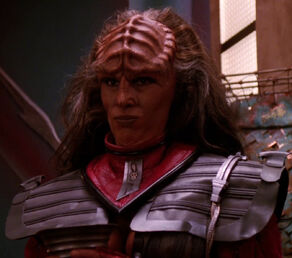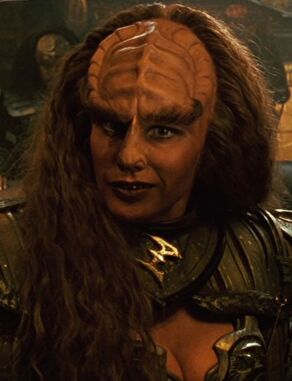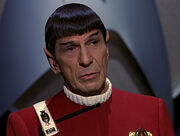This is the latest installment in a series of "Character Insight" articles regarding the rich history of characters in the Star Trek universe. An audio version will appear on the This Week in Trek podcast, available for direct download here.
--------------------
Welcome back to Character Insight! This week, we profile Dr. Tolian Soran, the primary antagonist from Generations. He comes in at number 7 on the list of best Trek movie villains.

(Does this look like a face you can trust? Hell, no!)
A couple weeks ago, we profiled Soran's co-conspirators Lursa and B'Etor on this segment, but Soran is the man behind the evil plots in this movie. Soran is an El-Alurian and therefore is the perfect type of villain to span across the decades from Kirk's time to Picard's time. During Kirk's era, Soran was one of a handful of survivors of a Borg attack on his homeworld and being temporarily trapped in the Nexus along with fellow El-Aurian Guinan.
Well, it wasn't a handful exactly, was it Mr. Scott? (Quote of the Week: "I got 47, out of 150" - 47 ALARM)
Yes, even the original crew couldn't escape the power of that number in the 1990's writing room. The brief flirtation with the Nexus drove Soran crazy to get back, as that allowed him to pretend to experience a life where his family and friends were not destroyed by the Borg attack. Thus, he embarks on a multi-decade mission to find a way to get back in the Nexus.
It also leads him to some great quotes showing how crazy and dedicated he is to returning to his happy place and leaving the memories and ravages of time: (Quote of the Week 2: "They say time is the fire in which we burn"). Which is exactly what needs to be said to convince Picard, who had just experienced a similar trauma of losing his family line in a fire.
The only way Soran can figure out how to make the Nexus pass through a planet is to destroy a star to move its path, which leads him to employ the Duras sisters to steal trilithium from the Romulans to make a weapon capable of such a supernova. And indeed, his evil plot succeeds when only Picard goes down to the planet to stop him. But thankfully, the Nexus has Captain Kirk trapped within it from the initial encounter where he was lost and the El-Aurians were saved by Montgomery Scott on the Enterprise-B.
So back to reality go Kirk and Picard to beat down Soran and prevent the total destruction of a star system and the Enterprise-D crew. Soran and Kirk can then stop worrying about past painful experiences as both die rather than go back to the Nexus. But Picard lives on for more movie fun!
The character of Soran is a fresh villain to the series but he fits right in to make a story spanning the generations. He also serves as an interesting character piece for Guinan, who came away from the Borg and Nexus experiences with a totally opposite outlook and drive than he does. Like Michael Gaines, I personally enjoy Generations largely based on Malcolm McDowell's performance in this well-written villain role.
McDowell has enjoyed a long 50 year career in the acting business, including highlight roles in A Clockwork Orange and many recent movies such as Bolt and TV series such as Entourage, The Mentalist, and CSI: Miami. (Insert Yow!). He currently has about 20 projects filming or in pre- or post-production, so look for a lot more of McDowell to be out there in the future.
Until next time, live long and prosper...
This is the latest installment in a series of "Character Insight" articles regarding the rich history of characters in the Star Trek universe. An audio version will appear on the This Week in Trek podcast, available for direct download here.
--------------------
Welcome back to Character Insight! This week, we profile V'Ger, the antagonist from The Motion Picture. This non humanoid villain of sorts comes in at number 8 on our best Trek movie villains countdown.

(Watch out for those light bubbles, they sting a bit!)
V'Ger is a vessel encased in an incredibly large energy cloud that tracks through the Alpha Quadrant through Klingon space on the way to Earth. The Enterprise crew is led to investigate why this mysterious cloud entity is coming for the home planet. Like the Whale Probe in Star Trek 4, V'Ger threatens to destroy Earth, this time with a number of plasma energy spheres located at equidistant points around Earth.
Unlike the Whale Probe, V'Ger attempts to communicate with ancient radio technology. As Kirk, Spock and Bones uncover the layers to this entity, it becomes clear that this is a relic of Earth's past, specifically the Voyager 6 space probe launched in the 20th Century by NASA. V'Ger was reprogrammed by a machine planet race to learn all it could learn and return to its creator.
In this process of learning, V'Ger became a conscious machine and struggles with complex, non-scientific concepts as a result of not having intuitive, irrational elements. That makes V'Ger want to merge with the human creator to gain this ability to process all the information it has gained. That allows the writers to get rid of Captain Willard Decker at the end of the movie as he merges with his former lover Ilia (Quote of the Week: "I am V'Ger") and V'ger, thereby giving the Enterprise back to Kirk and crew for more movie adventures.
Although V'Ger turns out to not be much of an actual evil villain, it makes viewers think about the long-term implications of space decisions made today. V'Ger also allows for Star Trek to take on a big sci fi concept much like the movie 2001: A Space Odyssey. This connection to reality makes V'Ger more compelling even for re-watching this movie, and that pushes this "villain" into the top 10 of this list.
V'Ger has since been linked many ways to potential other story lines of Star Trek. Gene Roddenberry proposed that the machine planet that reprogrammed V'Ger might have been the Borg home world, which led to a couple novels running with this concept. V'Ger also appears in the Star Trek Nero comics to explain how Nero used this machine to calculate precisely when Spock would reappear.
V'Ger could have ended up with a much different appearance, as the original visual effects house working on The Motion Picture wanted a much darker living machine that opened like a flower on the inside. But this visual effects house overstretched their capabilities and budget and was canned by Paramount, leading to the hiring of John Dykstra and Douglas Trumbull, who took the visual effects in a whole different direction that led to an Academy Award nomination.
Ilia, who ends up representing V'Ger in humanoid form to the Enterprise, was played by Persis Khambatta. Although she missed out on being a regular on the Star Trek Phase II series that was replaced with this movie, she did later appear in MacGyver and Lois and Clark before her passing in 1998.
Until next time, live long and prosper...
This is the latest installment in a series of "Character Insight" articles regarding the rich history of characters in the Star Trek universe. An audio version will appear on the This Week in Trek podcast, available for direct download here.
--------------------
Welcome back to Character Insight! This week, we profile Lursa and B'Etor from Generations, who come in at number 9 on our best Trek movie villains countdown.


(The dymanic duo of Klingon Kleavage)
Veronica: "How About a Boobie?" clip...Yes indeed, these sisters are a memorable duo that originally starred as antagonists of the two part episode Redemption. But they were likely brought back because they checked the box of one popcorn movie trope, that being...Scott Fletcher: "Boobies!" clip, or more appropriately, in Klingon, Scott Fletcher: "in Klingon, Kap'freah!" clip.
Thankfully, there is more than just Klingon kleavage here, as Generations continues the storyline of the Duras sisters trying to obtain funds and weapons to revolt and take over the Klingon Empire. After Picard failed to be seduced by B'Etor in the episode Redemption and Gowron was put in as chancellor instead of their nephew, the sisters were outcast and that led to a life of crime and rebellion.
These crimes include selling minerals to Bajoran terrorists, rigging a poker tournament in their favor, and finally, the plot to help Dr. Tolian Soran in Generations. Soran had Lursa and B'Etor act as the muscle of the operation, raiding a Romulan outpost for trilithium to make a weapon sufficient to make a star go supernova and move the nexus into the path of Soran.
Quote of the Week: "
I hope for your sake you were initiating a mating ritual."
The sisters intend to get the weapon for their own use after Soran's nexus plans. Which of course, successfully lead to Guinan on a carousel, and Picard and Kirk on horses...
"I'm on a horse!"
While the captains are off saving the world from Dr. Soran, the Klingon sisters take on the Enterprise in a long overdue battle. However, crazy acting captain Riker gets the best of Lursa and B'Etor's bird-of-prey and this recurring enemy exits stage left in a glorious space explosion.
They do get the honor of taking down the Enterprise-D though, as another iconic ship from the television shows gets the worst end of a movie plot. ("Brace for Impact!") Lursa and B'Etor make for a nice tie back to the stories in the latter seasons of the TNG series, as well as an interesting parallel to the enemies of Kirk's era. While the return villains are memorable and a strong choice for this role, the plot itself is rather weak and the sisters seem more like eye candy than legitimate muscle in their secondary villain role of this operation.
Still, the tie-back and strong motivations for helping Soren push these sisters into the top 10 of our villain list. Plus, these sisters are eclipsed on this list by only one other role as a female villain, which is a nice change of pace that Star Trek should do more often.
Barbara March and Gwynyth Walsh played Lursa and B'Etor, and you will be happy to know that the TNG Companion confirms that neither has to use chest padding to fill out those interesting Klingon uniforms. Cleavage jokes aside, March pretty must stopped acting after this movie, while Walsh has remained very active in various TV movies and series through this year, including a recurring appearance on NYPD Blue.
Until next time, live long and prosper...
This is the latest installment in a series of "Character Insight" articles regarding the rich history of characters in the Star Trek universe. An audio version will appear on the This Week in Trek podcast, available for direct download here.
--------------------
Welcome back to Character Insight! This week, we profile The Whale Probe from The Voyage Home, who comes in at number 10 on our best Trek movie villains countdown.

(When forehead of the week becomes facelift of the week)
Although one of the cooler ideas presented by Star Trek movies is a menacing machine as a primary villain, the whale probe just breaks into the top 10 because it ends up servicing one of the strangest plots devised for a Trek movie.
I personally love the camp of Star Trek IV, but many fans hate it because it made Star Trek into a comedy, it focused on present-day 1980's Earth, and it slammed a cheesy "Save The Whales" story line down the consumers' throats. This movie is basically Free Willy, before Free Willy was cool.
"Free Willy Theme"
Nevertheless, the whale probe is a large cylindrical member with a ball-shaped antenna that emerges to amplify a signal the cylinder makes trying to communicate with whales. However, that species had been extinct for quite some time in the 23rd Century, so the whale probe disables all ships and technologies and begins to vaporize Earth's oceans in an attempt to search for the missing whales.
That leads Kirk and crew in the stolen Klingon Bird of Prey from Star Trek III to slingshot around the sun and go back in time to bring whales back from the 1980's. Hilarity ensues.
"Nuclear Wessels!"
Of course Kirk saves the day and brings the whales back to save Earth. At which point the whale probe stops this noise (Quote of the Week: Insert probe noise) and goes back to wherever it came from. That'll teach those pesky human hunters a lesson!
The more interesting stories about the whale probe come from those at Industrial Light and Magic, the crew tasked with making this probe come to life on the silver screen. The probe was initially blue and white to look a bit like a whale, but the crew could not get the cylinder to shoot correctly in such a form, so the textured black surface was used. The ball-shaped probe was also originally orange, but that looked too much like a basketball so it was washed out to the blue from the final movie. Now it looks like a volleyball instead.
"Doh"
ILM made three different models of the whale probe, one of which is just a large section used for flying over the screen like similar shots used in Star Wars movies. The self-illuminating glow was provided by a long tube lamp as well as a number of halogen bulbs at the hole where the antenna comes out. This was high-level incredible visual engineering, even if it ends up wasted on a relatively simple popcorn version of Star Trek.
The Whale Probe makes what could've been a disastrous dumb premise for a Trek movie into something pretty interesting. Plus, the visuals are pretty cool, so this villain turns out to be one of the best the movies had to offer.
Until next time, live long and prosper...
This is the latest installment in a series of "Character Insight" articles regarding the rich history of characters in the Star Trek universe. An audio version will appear on the This Week in Trek podcast, available for direct download here.
--------------------
Welcome back to Character Insight! This week, we celebrate 100 segments by giving the most iconic character in Star Trek lore the first repeat appearance on this segment. That character being Spock, of course.
"Live Long and Prosper"

(Who would've guessed this would only be halfway along the journey of five decades for Leonard Nimoy Trek appearances?)
Today this segment will focus on Spock of the TOS movies because this is where the character really takes a different slant, and also because the movies are a current focus of this segment with the best villains series. The movies are where the dual culture of Spock really comes out in full force, as he swings between seeming fully Vulcan and strong moments revealing humanity as well.
When we first see Spock in the movies, he has just aborted a kolinahr ritual he had chosen to remove the displays of emotion he was prone to during the five-year mission. However, the V'Ger mission drew him back in, and while he was more steadfastly emotionless and Vulcan at this point, he realized the benefits of staying the way he was for the benefit of his friends on the Enterprise and in Starfleet.
Spock then becomes a Captain and trains academy students on the Enterprise before being drawn back in as Kirk's first officer for the missions against Khan and the Whale Probe. Between those two encounters, Spock is resurrected by rejoining his Vulcan soul or katra with his body, which was regenerated by the Genesis planet, and this leaves him acting more Vulcan and emotionless over much of the remaining TOS movies. It is interesting that Spock retires with the rank of Captain and as an ambassador rather than as a flag rank like Admiral, which is different than his close friends Kirk and Bones.
Although Spock was always there for Kirk and his crew when needed (QOTW: "I Have Been, and Will Always Be, Your Friend"), he follows his own path to build an even more unique officer and character in the movies. That unique character development such as his ambassador role leads to many natural storyline tie-ins that led to his appearances on TNG, plotlines on Voyager, and his re-appearance in the JJ Abrams reboot movies also.
In my opinion, Star Trek is not a success and does not exist today without the great work of Nimoy on this character. For example, the TOS crew likely does not do over four more movies post-The Wrath of Khan, had Nimoy not agreed to come back. Spock is the lynchpin of diversity and science fiction that makes this franchise memorable and important in the cultural pantheon.
Leonard Nimoy played Spock, and he will lend his voice talent to the upcoming Kingdom Hearts III game, for those interested in his most recent work. Did you know he, like Shatner, also tried to have a singing career? Check out this gem from a few decades ago: (Insert "Bilbo Baggins" chorus)
Until next time, live long and prosper...






